The Ultimate Wedding Ceremony Guide

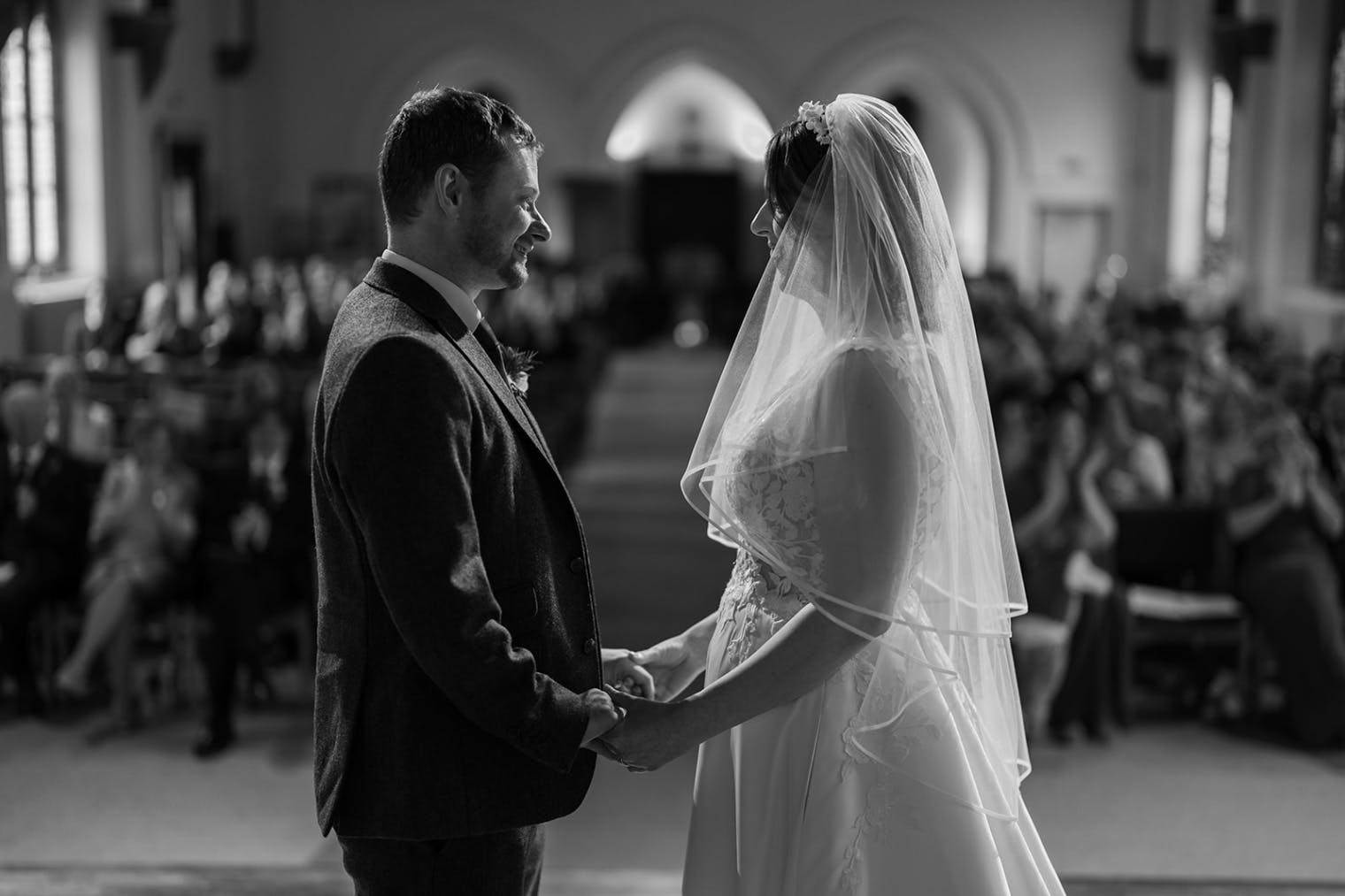
Your wedding day will be filled with love, excitement and magic. Months or even years of planning will finally become reality as your family and friends gather to spend time with you as you and your partner come together as one. The entire day will be a whirlwind of emotions, but at no point will your emotions be quite as high as they are during your wedding ceremony – the moment when you and your partner exchange vows and tell the world about your commitment to one another.
With such an important moment not just on your wedding day, but potentially your entire life, you likely have a ton of questions bouncing around in your mind. What’s the traditional order? How do you give your loved ones a role in your wedding? How do you find the perfect venue, words to say, decorations, celebrant and more?
Yes, there’s a lot to think about when it comes to your wedding ceremony, but that doesn’t mean it has to be scary or overwhelming. All it takes is a little bit of research to make sure everything is checked off.
That’s where we come in. In this guide, we’re going to explore everything you need to know about a wedding ceremony, from the planning right up to the moment you’re stood at the altar and beyond. Then, to help with planning your very own wedding, sign up to Bridebook for all the resources and tools you could need to make it as simple as possible.
What’s the significance of a wedding ceremony?
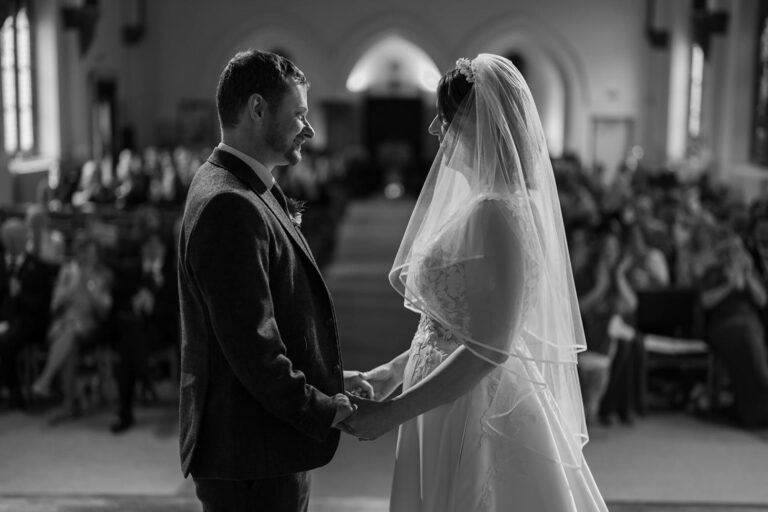
The wedding ceremony is the heart and soul of your wedding day. It’s the big moment you’ve been waiting for since the day you got engaged and promised to spend your life loving and caring for your partner. The wedding ceremony is the culmination of a long and chaotic wedding planning journey and is the moment the two of you start your marriage both from a spiritual and legal point of view.
It’s often what many couples consider to be the most nerve-wracking part of a wedding. It’s the one part you want to go perfectly, as you stand in front of your family and friends and exchange vows with the love of your life. Thankfully, with a little preparation and by choosing the right professionals and vendors, your wedding ceremony can be exactly like it is inside your head.
What’s the traditional wedding ceremony order?
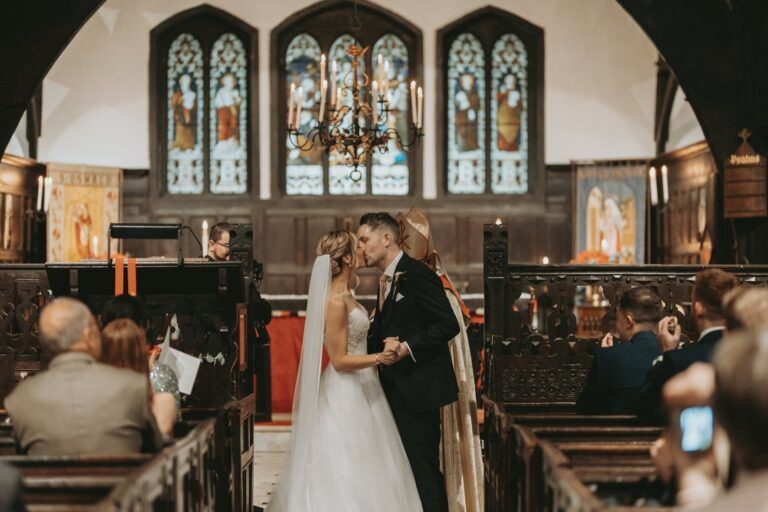
The morning of your wedding will be fast-paced and whizz past before you even realise it’s time to make your way to the venue. The excitement will build and you might feel jittery, but it’ll soon be time to start your wedding ceremony.
As you get ready and make your way to the venue, your guests will have slowly been arriving. Depending on what you’ve chosen, they might enjoy some welcome drinks and a few canapés while getting swept up in the excitement. Then, once it’s time, they’ll be shown to their seats by the ushers and the ceremony can start.
And it should look a little something like this:
1. The processional
The traditional order for walking into the venue and either taking their seats or standing at the altar is:
- Bride’s mum
- Groom’s parents
- Bride’s grandparents
- Groom’s grandparents
- Groom
- Officiant
- Bridesmaids
- Maid of honour
- Best man
- Ring bearer or page boy
- Flower girl
- The bride and her father
You’re likely to have music playing at the venue to welcome guests as they find their seats. This, of course, will change as the wedding is about to begin and the bride walks down the aisle. Depending on your preferences, the music might be prerecorded or played live by a musician. The music then fades out as the two of you meet.
With modern and same-sex weddings, new traditions are forming that are variations of the traditional processional in the UK. Both partners may choose to walk down the aisle together, or neither may want to do it like this. The best thing about your wedding is that it’s yours, so you’re free to arrive however you feel comfortable.
2. The welcome
Once the two of you are stood at the front, the officiant (or celebrant if you choose to have one) will welcome everyone to your big day. You may ask them to give a specific greeting, and they may use some humour if this is something you’re happy to include. If your wedding ceremony is religious, the welcome may have a set structure. This will introduce your guests to the day and help you feel at ease.
3. A song or reading
If you’re having a religious ceremony, following the welcome there would traditionally be a hymn. Even if you’re not religious, this is still something you can include, but it isn’t common. Instead, you might ask a friend or loved one to do a reading, which might be a poem, an extract from a story or play, or even lyrics from a song that’s personal to you and represents your journey as a couple.
4. The marriage ceremony
The officiant will remind the couple of their obligations to one another with the charge. This is when they explain what it means to be married and what the couple must do to ensure they’re upheld. This includes their responsibilities and the meaning of the vows they’re about to exchange.
Next, the officiant will ask a question that’s been the catalyst for many dramatic moments in rom-coms: Does anyone know of any reason in law why the couple should not be married? This, of course, is usually met with silence, much to the relief of the couple.
You and your partner will then exchange vows, which the officiant will run through with you slowly (so you don’t have to remember an entire Shakespearean soliloquy). If you’ve chosen to write your own vows, you will have given these to the officiant beforehand to make sure they comply with the relevant rules. Just remember there are specific words you have to say to make sure your marriage is legal.
It’s during this stage when the two of you will say another famous wedding ceremony staple, the I dos. Thankfully, this is one of the most exciting parts, as well as being one of the easiest to remember!
5. The exchanging of the rings
If the two of you have chosen to wear wedding rings, this is when you’ll exchange them. If you don’t want to exchange rings, you will have spoken to your officiant beforehand to discuss an alternative (for some inspiration, read our post on ring alternatives).
If you are exchanging rings, it’s usually the best man’s job to hold on to these, or they could be brought to you by a young ring bearer if someone in your family or friend circle would suit the role. When the officiant asks for them, the best man will hand them over. The two of you, under the direction of the officiant, will then place the rings on each other’s ring fingers while reciting a phrase also guided by the officiant.
6. The declaration of marriage and first kiss
Phew, the scary part is over! Now, the officiant will say the words that proclaim the two of you are bound by marriage, saying something such as: By the power vested in me, I now pronounce you husband and wife (or a variation of this for LGBTQ+ couples).
Then, the officiant will encourage the two of you to kiss and you’ll have your first embrace as a happily married couple as all your friends and family applaud and cheer. There might also be one or two tears, too.
7. An additional song, reading or prayer
If you’re having a religious ceremony, this is when there’s an opportunity for a reading from scripture, a hymn or a prayer. Even in non-religious ceremonies, you may ask another loved one to perform another reading.
8. The signing of the register
The officiant will then invite you and your new spouse to sign the marriage license, which will also need to be signed by two witnesses whom you will have asked ahead of the big day (make sure you don’t spring this surprise on anyone that morning).
This usually takes around ten minutes and music will play to entertain your guests as they wait for you to finish.
9. The end of your service
After the two of you and your witnesses are done signing the register, the officiant will thank everyone for attending and invite them, on your behalf, to celebrate at your chosen venue where the breakfast and reception will take place.
10. The recessional
The two of you will now leave the venue accompanied by music as you make your way out. As you step outside, your guests will be waiting to shower you with confetti as your photographer snaps some fantastic photographs.
11. The photographs
You’ll then be joined by loved ones as your wedding photographer guides you all through the official photography process. There will also be many photos taken of just the two of you in and around the venue.
12. On to the breakfast and/or reception
Depending on whether your breakfast and reception are happening elsewhere, you may hop into your wedding transport to be whisked off to your next venue. If your ceremony and reception are taking place in the same venue, you’ll then either move on to another room or step out while the venue staff make changes to get ready for your breakfast. Then, all you have to do is enjoy yourself!
Wedding ceremony traditional order cheat sheet
If all of the above was a lot to take in, don’t panic! We’ve created a handy quick reference sheet sheet to illustrate the traditional wedding ceremony order, which you can save or event print out to return to whenever you need.
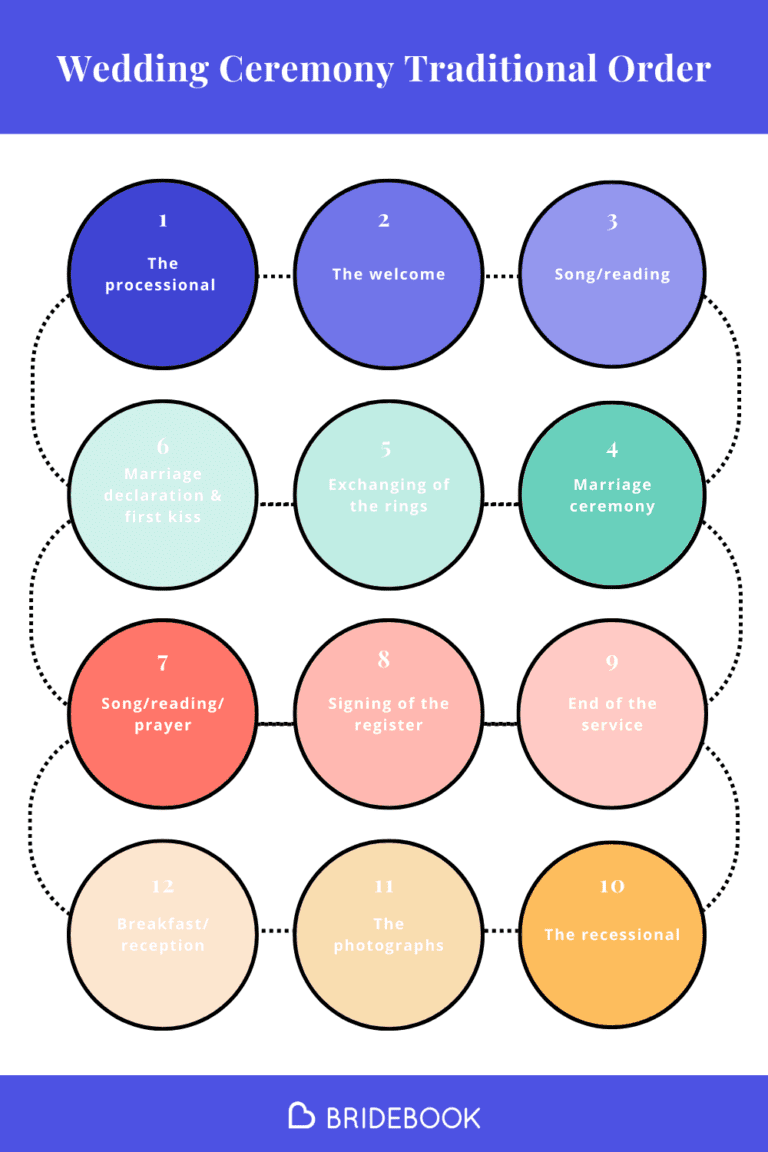
Do all weddings follow the same order?
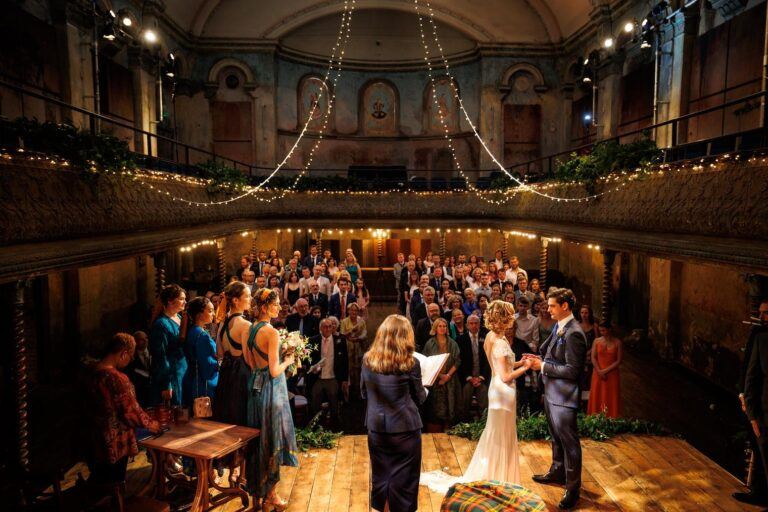
While the traditional ceremony order is often followed for weddings in the UK, this can differ depending on the type of ceremony you have, your religious beliefs, the size of your wedding or simply your own preferences. For example, a Jewish wedding ceremony can be different from a Hindu ceremony or a non-denominational wedding ceremony. Every wedding, regardless of culture or background, will follow a recognisable structure to ensure the marriage is legal. But, the order might vary to some degree.
How do you plan the perfect wedding ceremony?
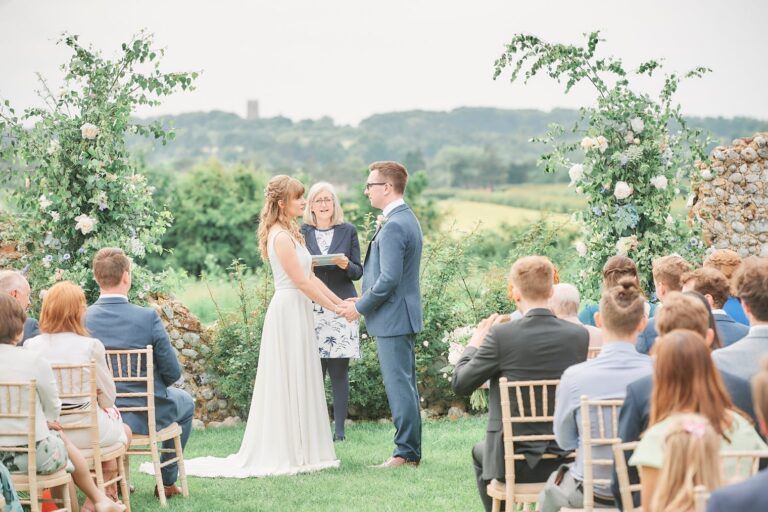
When planning your wedding, you’ll spend a lot of time and effort thinking about the venue, food, entertainment, favours and your cake, but it’s just as important to dedicate time to planning the ceremony itself, too.
So, here’s everything you should think about to make sure you plan your perfect wedding ceremony.
Understanding the budget for your wedding ceremony
Your wedding budget will likely include everything you need to have the wedding of your dreams. When putting your budget together, you should think beyond the breakfast and reception – which are the biggest expenses you’ll face – and ensure you also have enough to dedicate towards the ceremony itself. After all, it’s the main event!
You can use our wedding budget tool to work out exactly what you need so you can have the perfect venue, decorations, music, celebrant and more that will come together to become the wedding you’ve always dreamed about. Prioritise the must-haves and separate them from the nice-to-haves. With the average UK wedding costing £19,184, it’s important to be realistic when understanding your budget.
Choose the perfect venue for your wedding ceremony
When the time comes to choose your wedding venue, you’ll have a lot to think about. What type of venue suits your budget? Do you want a venue where you can have the ceremony, breakfast and reception all in one location? Do you want to get married in a church or place of worship?
When choosing the venue for your ceremony, there are plenty of options out there, so consider the following to ensure you have everything you need from your ceremony venue.
- Make sure you discuss what you want from your venue with your partner. The ceremony may just be an hour of your overall day, but it’s something that you’ll remember for the rest of your lives, so you want it to be something worth remembering.
- Don’t be tempted to go over budget, even if it’s a stunning venue. If you overspend on one thing, you’ll have to compromise on something else.
- Think about the space and whether it will comfortably fit all the guests you’d like to invite.
- Pay close attention to the lighting. This includes whether it allows a lot of natural light in, and if not, is there room for additional lighting?
- Try to visit your favourite venues more than once to make sure you get that feeling, so you know you’ve found the one.
For more help finding the right spot to say I do, read our top 10 tips for choosing your wedding venue. You can also browse our wide selection of venues to find the perfect place for you to host your ceremony.
Choose your decorations
Decorating your ceremony venue is more than just about the flowers. You might have a welcome sign, a seating plan, bunting, chair sashes, lighting, pew ends, aisle decor and more.
Make sure the decor you choose fits the overall theme of your wedding, but also ties into the natural aesthetic and beauty of your venue. If you’ve chosen a venue with a lot of natural beauty, such as a country house or place of worship, you might not need to enhance it by much. But if you’re getting married in a hotel or golf club, a little extra decor might just help bring your theme out a little bit more.
Choose your officiants and celebrants
If you’re having a religious ceremony, then it’s possible that your wedding will be officiated by a senior member of your local place of worship. If not, and you’re having a non-religious or multi-faith ceremony, then you may wish to choose your officiants and celebrants, as well as the registrar who will ensure your marriage is legal.
A celebrant is a great way to bring character and charm to your ceremony. You’ll meet with a celebrant a couple of times before the big day so they can create a highly personalised ceremony order and the words the two of you will share. We’d recommend speaking to a few celebrants to find one that fits with your exact vision.
Browse our range of wedding celebrants to find fantastic professionals close to you.
Choose everyone’s roles for the wedding
This is possibly something you’ve been thinking about forever, but now’s the time to set in stone how you’d like your friends and family to be involved in your wedding ceremony. This includes choosing a best man and maid of honour if you’re having one, as well as bridesmaids, ushers, page boy, ring bearer and flower girl.
Traditionally, the father of the bride gives his daughter away after walking her down the aisle, but in many modern weddings, couples might flip this, so that both parents walk the bride down the aisle, just the bride’s mum, or you and your partner might choose to walk down the aisle together.
Whoever you ask to play a role in your wedding, just make sure you’re understanding and accommodating, and show your appreciation to everyone involved.
Choose the perfect seating plan
Traditionally, the seating plan at the wedding ceremony is relatively straightforward: the groom’s family and friends sit on one side of the aisle and the bride’s family and friends sit on the other. However, this all depends on whether the two of you have a relatively equal number of guests each. If not, the seating plan at the ceremony can feel a little lopsided.
Much like the seating plan at the breakfast, you can seat your guests wherever you like, with maybe the exception of parents, grandparents, kids and other close relatives. Or, you can let them choose. Whatever works for you.
Choose your wedding vows
When it comes to your vows, you have two options: either use traditional vows (which might be determined by your faith if you have a religious wedding) or write your own. Writing your own might sound scary, but it’s something many couples opt for with modern weddings. It helps personalise your wedding and tell your partner – in front of your family and friends – exactly how you feel about them.
Discuss with your partner whether you’re brave enough to write your own vows, or if you’d prefer to go with something a little more traditional. It’s a super emotional thing to do, and some people can struggle to express how they feel using words.
For a little inspiration, read our post on how to write personalised wedding vows.
Hire your photographer and/or videographer
For many couples, hiring a photographer (and even a videographer) is a major non-negotiable. It’s the best way to capture your wedding so you can look back on it forever.
When you hire a photographer for your wedding, you can choose to hire them just for the ceremony, which also includes the family shots straight afterwards, or a package that includes the ceremony, the breakfast and the evening reception (and maybe even an engagement photoshoot as well). They’ll even capture the exciting build-up to the wedding as you get ready with your loved ones.
For help finding the right photographer, read our article on how to choose the perfect wedding photographer. Then, browse our selection of photographers to find fantastic professionals close to you.
Decide what wedding ceremony traditions you might like to uphold
When it comes to weddings, there are dozens, if not hundreds, of traditions. Some of them go back hundreds of years but are still included in weddings to this day.
For example, many brides like to include something old, something new, something borrowed and something blue as part of their wedding outfit. It’s also common for couples not to see each other on the morning of the wedding until their eyes meet as the wedding ceremony begins.
Think about what kind of wedding traditions you’d like to include in your wedding ceremony. For more information, read our posts on our 10 favourite wedding traditions and black wedding traditions to honour your heritage.
Decide your wedding ceremony music
When it comes to the music you have at your wedding ceremony, you actually have a wider choice available to you (depending on your budget) than you might realise. There’s a huge choice of music to suit a range of tastes, preferences, budgets, traditions and styles. When it comes to your music, think about the following:
- Do you want live music or pre-recorded?
- What kind of music do you want to play as your guests take their seats?
- What mood do you want to set?
- Do you want to be traditional or have something a little more modern?
- What music do you want during the procession?
- What music do you want as you walk down the aisle?
- What music do you want to play as your sign the register?
- What music would you like to walk out of the ceremony to?
See what we mean? Music plays a key role throughout your wedding day, from the moment you arrive at the ceremony to the moment you leave the reception at the end of the night. Take your time and think about the music you want at your ceremony, including the mood it sets and the meaning behind it.
Decide if you want any readings
Whether you have a religious ceremony or not, you may choose to have readings at your wedding. Readings are a great way to include loved ones in your ceremony who might otherwise not have a role, and help add a touch of personalisation and style. A reading can be anything, from a poem to your favourite song lyrics. They can also be a verse or two from a religious text. Whoever does them and whatever they read, just make sure they’re in keeping with the tone, theme and style of your wedding. For example, a funny reading might not work if you’re going for a more traditional vibe.
Have a plan B (especially if your wedding ceremony is taking place outside)
Since the law in the UK changed in 2022 to allow for weddings to take place outside, couples have seized the opportunity to get married in a wider variety of venues and locations. From gardens and parks to castles and manors, there are now a lot more places you and your love can exchange vows.
The only downside is, the weather in the UK doesn’t always behave itself. Yes, your wedding might be booked during July when there’s every chance we’re in the midst of a heatwave, but it’s never guaranteed. In the event the heavens open or there are 75mph winds, make sure you discuss a backup plan with your chosen venue just in case.
Decide if you want a rehearsal
Few would argue that the ceremony is the single biggest and most important aspect of your wedding day. If something doesn’t quite go to plan at the breakfast or reception, there’s so much going on that it doesn’t really matter if there’s a minor hiccup or two. However, at the ceremony, when all eyes are on you, you probably want everything to be perfect.
That’s why many couples choose to have a rehearsal. In the US, wedding rehearsals are fairly common, but in the UK, unless you’re having a religious ceremony, they’re far less so. But, if you have the budget available, a rehearsal is never a bad thing to have to ensure everyone knows exactly what they’re doing on the big day.
What do you need to remember for the morning of the wedding?
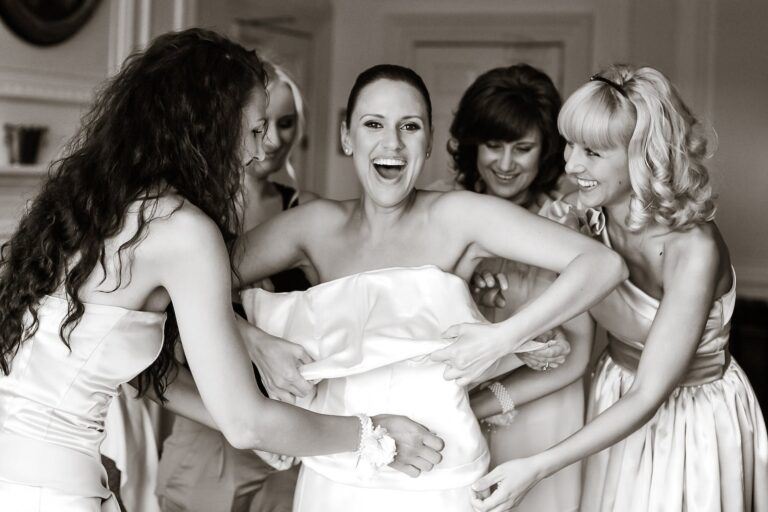
During your last few hours of single life, there will likely be a million and one thoughts whirling around your mind. Everything from worrying about your outfit fitting just right to whether or not the flowers will turn up on time will bounce around your head. Even tiny, insignificant things will feel huge as the excitement and nerves build. That’s why it can be easy to forget key things during the build-up to the ceremony. With that in mind, here are just a few things you should remember on the morning of the wedding:
- Remember to pack some wedding day essentials you might need throughout the ceremony, such as lip balm, tissues (definitely tissues), deodorant and your phone. You can keep these in your pocket, a clutch or leave them with someone you trust so you don’t have to worry about carting things around all day.
- Make sure you eat a decent breakfast. Your wedding day is a long one, and after getting ready, the ceremony, the photos and welcoming everyone to the breakfast, it’ll be two or three o’clock before you even know it – and your stomach will be growling. A good breakfast will keep you fuelled so you don’t need to keep thinking about what time you get to sit down for your first meal as a married couple.
- As well as getting ready for your big day, make sure you stick to some of your usual routines. Mainly, your skincare routine, because disrupting the status quo might upset your skin during a time when you might already be a little stressed. Don’t try something new at the last minute just in case your skin doesn’t like it.
- From the moment you step out of your home or hotel room before the ceremony, you’ll probably be wearing a dress, suit or other type of outfit that might be a little tight in places or dig in here or there. So, until that time comes, wear the comfiest, snuggliest thing you can get your hands on.
- Don’t leave anything to the last minute and give yourself plenty of time to get ready. Your guests and members of the wedding party will probably have a ton of questions for you about this and that, and allowing for enough time to get ready will prevent unnecessary stress.
- Try to establish a calm atmosphere in and around where you’re getting ready, so keep chilled-out people close by and listen to some of your favourite music.
- Your wedding ceremony will go by so fast that before you know it you’ll be sat eating the starter at your breakfast. Try to take everything in and enjoy every single moment.
What happens when the time comes to walk down the aisle?
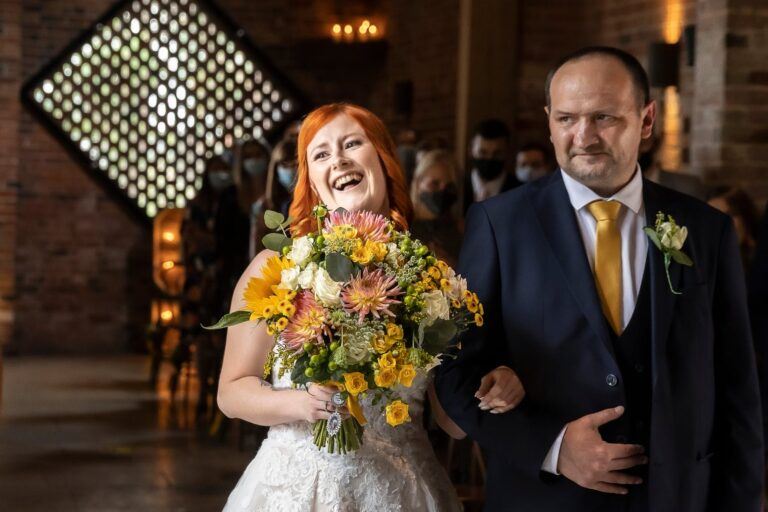
As the moment arrives for your wedding ceremony to start, there’ll be so much excitement from your guests as they take their seats on either side of the aisle. There’ll also be a few nerves, mainly from yourself, but they’ll soon go when you see your partner and all feels right with the world. But what happens when the time comes to walk down the aisle and become a married couple?
Let’s say your ceremony begins at 12pm. One of the happy couple, usually the groom, will be at the venue to welcome guests who will have been filtering in for the last hour or so, and who will start to take their seats around 15 – 20 minutes before the ceremony starts. Your planner or someone at the venue will keep a lookout for the arrival of the bride to alert the rest of the team and guests that the ceremony is imminent.
Once everyone at the wedding is seated and the bridal party is ready in a room outside the ceremony room, everyone lines up. When it’s time for the processional to start, the music will change to the song you’ll have chosen ahead of time.
Depending on who is in the bridal party, the order will go a little like this:
- Officiant
- Bridesmaids
- Maid of honour and best man
- Ring bearer or page boy
- Flower girl
- The bride and her father or parents
As you meet your partner at the front, your loved ones watching on, the officiant will guide you and your guests through the ceremony. At a same-sex ceremony, it’s entirely up to you whether you follow a similar order to this, walk down the aisle together, or do something else entirely. It’s your wedding, so you’re free to do it however you like!
What are the traditional wedding ceremony words?
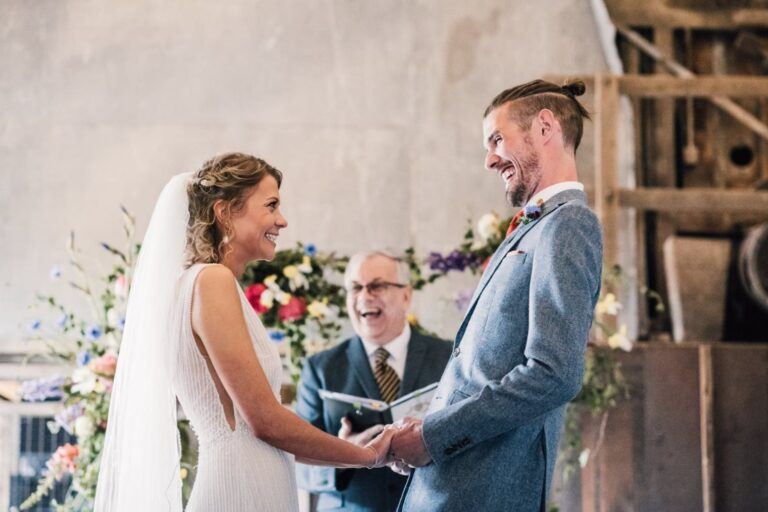
The vows you’ll have at your wedding will be determined both by your personal preferences and whether or not you’re having a religious ceremony. You may choose to write your own vows, but many couples still opt to use traditional vows.
Remember, a certain portion of your vows have to follow the legal process to ensure your marriage is binding, so while you’re free to personalise them, you do still need to follow the rules. The legal declaration and contracting words will usually be along these lines:
Declaratory words
“I do solemnly declare that I know not of any lawful impediment why I, [YOUR FULL NAME], may not be joined in matrimony to [YOUR PARTNER’S FULL NAME].”
Contracting words
“I call upon these persons here present to witness that I, [YOUR FULL NAME], do take thee, (YOUR PARTNER’S FULL NAME) to be my lawful wedded [WIFE/HUSBAND/SPOUSE/PARTNER IN MARRIAGE]. I promise to care for you, to give you my love and friendship, and to respect you and cherish you throughout the rest of our lives together.”
How to get the perfect wedding ceremony shots for your wedding album
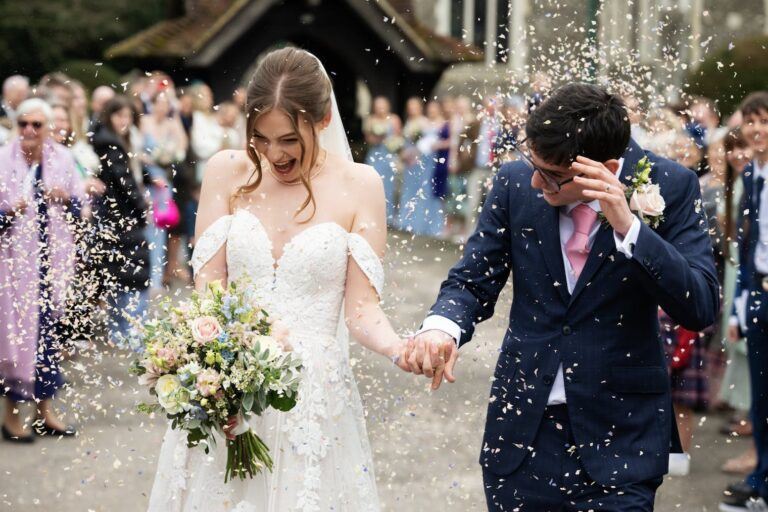
If you’ve hired a professional wedding photographer, they’ll spend a lot of time before, during and after your ceremony making sure you have wonderful photographs that you can hold on to forever. During the run-up to and during the ceremony, your photographer should take a lot of candid, natural photographs, meaning you’re free to get ready and enjoy your ceremony. That means it’s one less thing to worry about, so don’t look out for your photographer, and if you see them try to resist striking a pose unless they ask.
There may be a few mini photo sessions, such as the bride with her parents before the ceremony, but the main photo shoot will follow the ceremony, when the two of you will take plenty of pictures, as well as those involving your family and friends. One of the big ones is the traditional confetti shot, which involves you walking between two rows of guests as they shower you with colourful confetti. A skilled photographer will know exactly what to do to make sure everyone’s in the right position to get the best possible shots.
It may not be in your nature to pose for photographs but try to embrace the moment and enjoy it. To help calm the nerves that may come with your wedding photos, consider a wedding photographer package that includes an engagement photoshoot, which can make you feel more comfortable in front of the camera.
What happens after the ceremony?
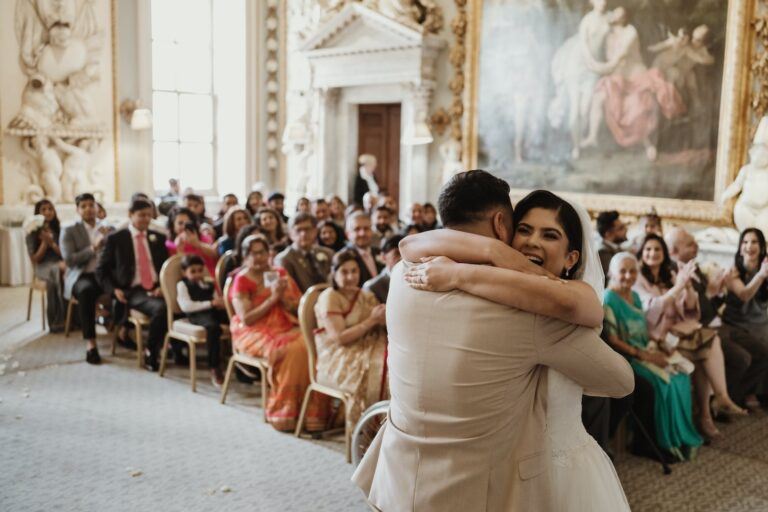
After the ceremony is over and you’ve signed the register, the two of you are declared as legally married. Phew! You can now enjoy the rest of your wedding day, starting with the obligatory photoshoot if you’ve hired a professional photographer.
Following the photos, what happens next depends on what you’ve chosen for the remainder of your big day. Traditionally, if your ceremony was around lunchtime, you and your guests will move on to the breakfast (which may or may not be at the same venue as the ceremony), which includes a meal and toasts. Then, during the afternoon and into the early evening, the venue may get ready for the evening reception, where there might be more food, drinks and dancing.
For more information, read our post featuring the best wedding day timeline.
What are some alternative wedding ceremony ideas?
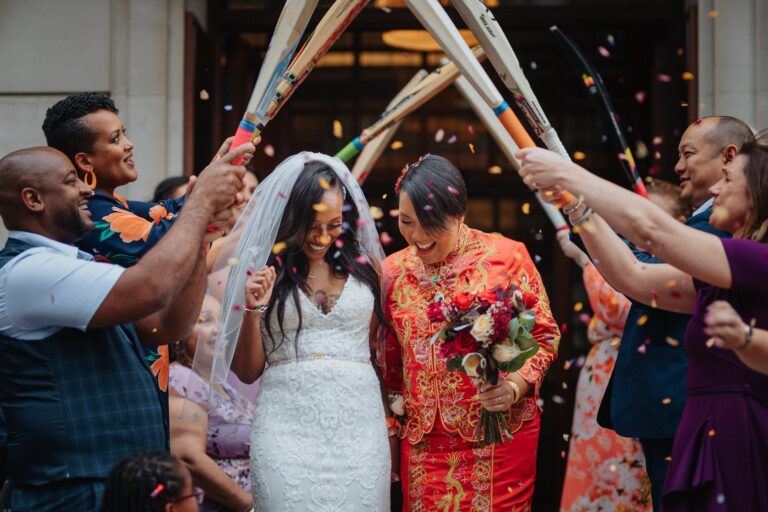
Traditional wedding ceremonies can be beautiful, whether intimate or grand. However, if you’re not particularly fond of the idea of following tradition, you can choose to do something completely different. That way, your wedding ceremony can be in keeping with what you have in mind for the rest of your big day and fit perfectly with your personalities. So, here are five alternate wedding ceremony ideas you might want to think about.
- Twilight wedding ceremony: A twilight wedding is a wedding that takes place during the latter part of the day, so you can take advantage of the magic and beauty that comes once it starts to get dark. With a twilight wedding there are tons of opportunities to get creative with lighting.
- Destination ceremony: Just think about how blissful it would be to get married on a white sandy beach, surrounded by acres of woodland or on a rooftop overlooking New York City. With a destination wedding, the world is literally your oyster.
- Themed ceremony: With some carefully sourced and made props and decorations, you can put together an immersive, themed ceremony that’s personalised and unique. Steampunk, vintage, Hollywood premiere, botanical… there are so many themed ceremony ideas to choose from.
- Adventurous ceremony: If you love the great outdoors, why not swap your suits and dresses for hiking gear, a wet suit or snow shoes and have a wedding ceremony somewhere adventurous?
- Surprise ceremony: Give your guests a surprise they’ll never forget by inviting them to what they think is just an ordinary party. Except, suddenly the doors open and they’re invited to take a seat to watch you get married. Imagine how excited everyone would be!
Plan your big day with Bridebook
Sign up to Bridebook and you’ll get access to all the tools, information and resources you need to plan the wedding of your dreams.
Browse other similar articles…
- The Best Wedding Day Timeline
- How to Choose Your Wedding Party
- Everything You Need to Know about Page Boys
- Everything You Need to Know about Flower Girls


